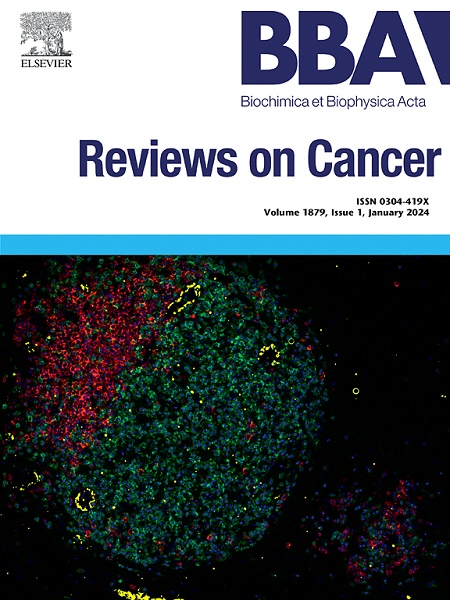Tertiary lymphoid structures achieve ‘cold’ to ‘hot’ transition by remodeling the cold tumor microenvironment
IF 9.7
1区 医学
Q1 BIOCHEMISTRY & MOLECULAR BIOLOGY
Biochimica et biophysica acta. Reviews on cancer
Pub Date : 2025-04-04
DOI:10.1016/j.bbcan.2025.189312
引用次数: 0
Abstract
Immune checkpoint blockade (ICB) therapies have demonstrated significant clinical efficacy in immune-infiltrated tumors such as melanoma and non-small cell lung cancer. However, “cold tumors”—including ovarian cancer, pancreatic cancer, and gliomas—exhibit insufficient immune infiltration, leading to poor therapeutic responses to ICBs and limited improvement in patient prognosis. Recent studies have shown that tumor-associated tertiary lymphoid structures (TLSs) can induce strong local immune responses within the tumor microenvironment (TME), serving as important biological markers for predicting ICB therapy efficacy. Notably, preclinical and clinical studies on cold tumors have confirmed that TLSs can potently enhance ICB efficacy through TME remodeling—a breakthrough that has attracted considerable attention. Here, we systematically examine the immunological profile of cold tumors and decipher the mechanistic basis for their impaired immune cell infiltration. We further delineate the distinctive features of tumor-associated TLSs in generating antitumor immunity and establish criteria for their identification. Significantly, we emphasize the unique capability of TLSs to reprogram the immunosuppressive tumor microenvironment characteristic of cold tumors. Based on these insights, we evaluate clinical evidence supporting TLS-mediated enhancement of ICB efficacy and discuss emerging strategies for exogenous TLSs induction.
三级淋巴结构通过重塑冷肿瘤微环境实现“冷”到“热”的转变
免疫检查点阻断(ICB)疗法在免疫浸润性肿瘤如黑色素瘤和非小细胞肺癌中显示出显著的临床疗效。然而,“冷肿瘤”——包括卵巢癌、胰腺癌和胶质瘤——表现出免疫浸润不足,导致对ICBs的治疗反应较差,患者预后改善有限。最近的研究表明,肿瘤相关的三级淋巴结构(TLSs)可以在肿瘤微环境(TME)内诱导强烈的局部免疫反应,是预测ICB治疗效果的重要生物学标志物。值得注意的是,冷肿瘤的临床前和临床研究证实,TLSs可以通过TME重塑有效增强ICB的疗效,这一突破引起了广泛关注。在这里,我们系统地研究了冷肿瘤的免疫学特征,并破译了其免疫细胞浸润受损的机制基础。我们进一步描述了肿瘤相关TLSs在产生抗肿瘤免疫方面的独特特征,并建立了鉴定标准。值得注意的是,我们强调了TLSs重编程冷肿瘤免疫抑制肿瘤微环境特征的独特能力。基于这些见解,我们评估了支持tls介导的ICB疗效增强的临床证据,并讨论了外源性tls诱导的新策略。
本文章由计算机程序翻译,如有差异,请以英文原文为准。
求助全文
约1分钟内获得全文
求助全文
来源期刊

Biochimica et biophysica acta. Reviews on cancer
医学-生化与分子生物学
CiteScore
17.20
自引率
0.00%
发文量
138
审稿时长
33 days
期刊介绍:
Biochimica et Biophysica Acta (BBA) - Reviews on Cancer encompasses the entirety of cancer biology and biochemistry, emphasizing oncogenes and tumor suppressor genes, growth-related cell cycle control signaling, carcinogenesis mechanisms, cell transformation, immunologic control mechanisms, genetics of human (mammalian) cancer, control of cell proliferation, genetic and molecular control of organismic development, rational anti-tumor drug design. It publishes mini-reviews and full reviews.
 求助内容:
求助内容: 应助结果提醒方式:
应助结果提醒方式:


